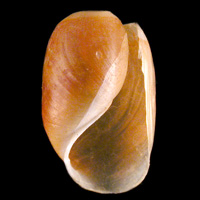|
< Previous family introduction |
|
|||||
 |
Family Akeridae Akerid bubble shells
|
|||||
|
The Akeridae is a numerically small family with fragile, elongate shells. Its grouping with the sea hares (order Anaspidea) is now accepted, though it was vigorously contested up until recently. The sea hares have only internals shells, but in the Akeridae the tendency to shell reduction has not progresses that far, and the shell is still external, although it is not large enough for the animal to withdraw into completely. The animal can swim when disturbed with its large foot. There are only five living species in the family; two are found in the Indo-West Pacific and three in the Atlantic Ocean. The shell of the Akeridae is thin, fragile and initially translucent, becoming opaque with age. The animals burrow in silty to muddy substrates down to about 10 m depth. Their occurrence is cyclic, sometimes appearing abundantly in areas where they have been absent for years. They appear to feed on Cyanobacteria and algae (Gosliner et al., 2015). The only species occurring in NSW is Akera soluta which occurs throughout the Indo-West Pacific region, extending southwards to eastern Victoria. Family Reference Morton, J.E. 1972. The form and functioning of the pallial organs in the opisthobranch Akera bullata with a discussion on the nature of the gill in the Notaspidea and other tectibranchs. The Veliger 14(4): 337-349. Morton, J.E. & Holme, N.A. 1955. The occurrence at Plymouth of the marine opisthobranch Akera bullata, with notes on its habits and relationships. Journal of the Marine Biological Association, United Kingdom 34: 101-112. Coverage The only species that occurs in NSW is detailed here. Identification Notes The shell is up to 45 mm in length, fragile, with the last whorl not attached at the spire over the last half whorl.
|